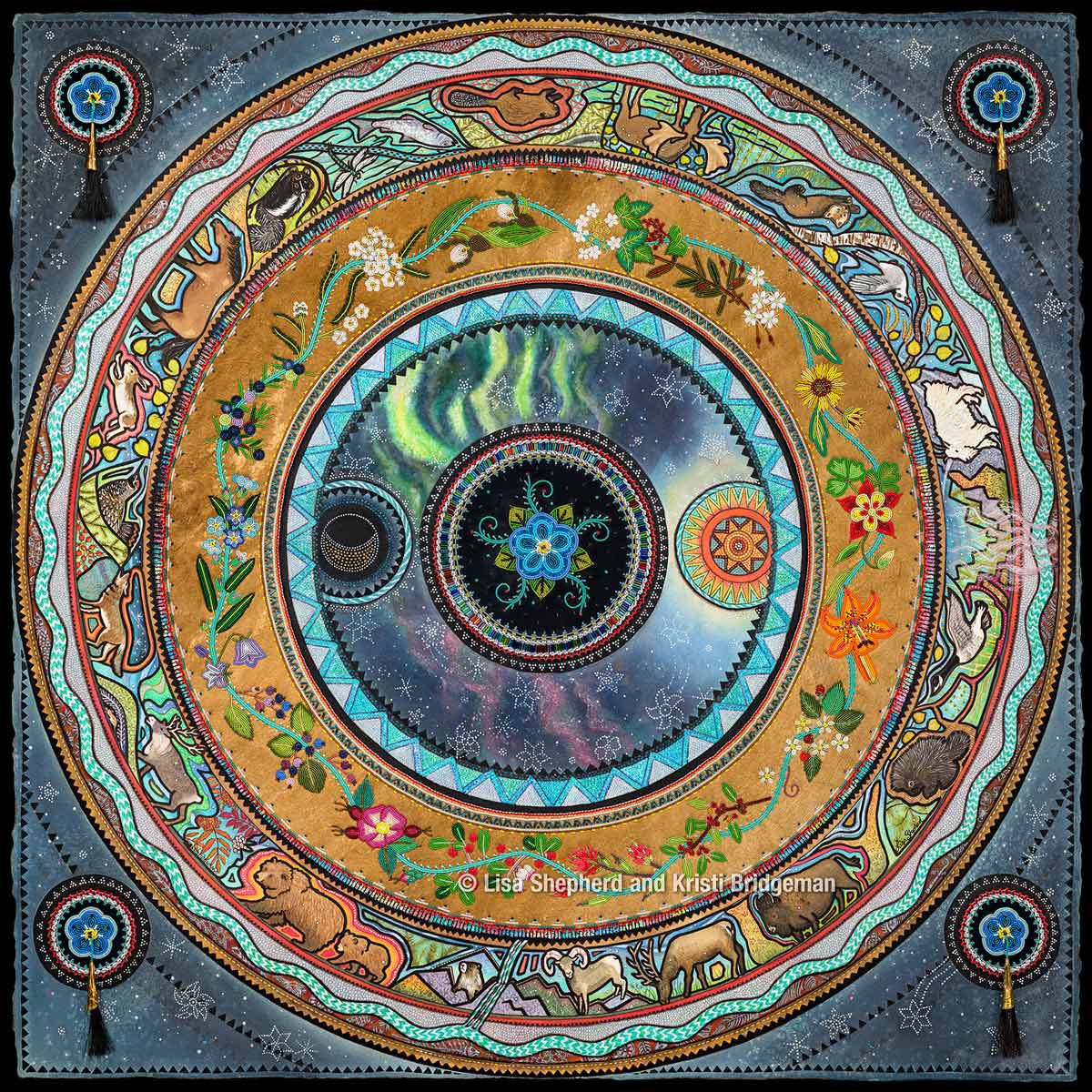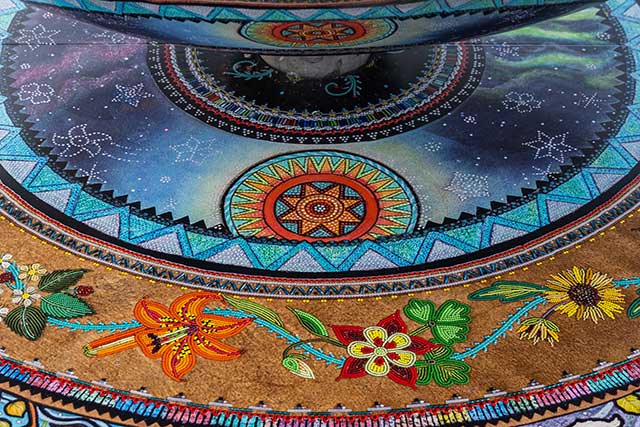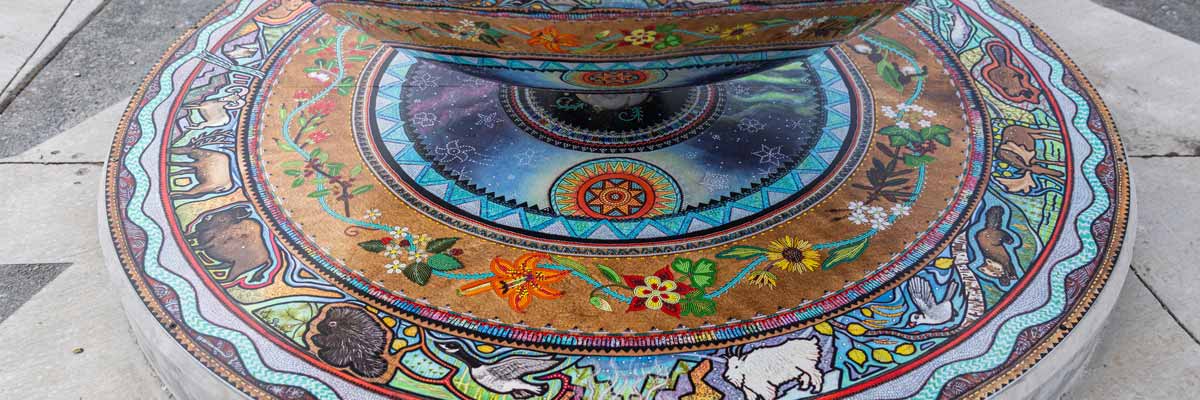Wahkohtowin artists' statement
Jasper National Park
Métis artists Lisa Shepherd and Kristi Bridgeman created the base art for the Jasper Indigenous Exhibit. They contributed the text for this webpage to share the story behind their stunning art piece, Wahkohtowin.
Wahkohtowin is Cree natural law. It acknowledges kinship relations between all of the natural world. When we respect wahkohtowin, we recognize and honour our responsibility to all our kin. All plants, animals and elements are related and stand equal in the circle, connected to one another. Although Cree law, traditional Métis people also understand and respect wahkohtowin. When we talk about this concept, Mother Earth and all natural elements, we all agree, regardless of the diversity of our nations.

The original beaded artwork is on display in the Visitor Information Centre.
© Lisa Shepherd and Kristi Bridgeman. Reproduction of this image is not permitted.
Background to the artwork
Lisa Shepherd and Kristi Bridgeman began the art creation process with a knowledge sharing session with Indigenous partners of the Jasper Indigenous Forum. The artists wanted to ensure the final piece was inclusive of the diverse stories, traditions and knowings. Wahkohtowin acknowledges how all of the natural world is related, and our responsibility to all our relations.
A journey through the artwork
The artwork’s story can be read from outer edge, inward. From fossils, progressing inward to this moment in time.

Beginning at the outer edge: The glowing fossils speak of the land since time immemorial. The glaciers melt, revealing fossils from the Devonian Period – when the continental divide was a vast ocean alive with creatures such as trilobites, ammonites, and various other ancient water dwellers.
Glacial rivers: Symbolized by the turquoise undulating design. From the Mountains of the Great and Arctic divide, the beautiful ice-green glacial rivers flow downward in all directions, reaching both Pacific and the Atlantic oceans, sustaining life for animals, plants and humans along its journey.
Animals and habitat: The animals included in this piece were chosen as priority animals by various Indigenous communities. They have been placed directionally based on where they might be found in the Jasper area. Flora and fauna are represented with at least one example of their habitat and a ribbon of spirit wind that weaves throughout, connecting all our relations.

Our plant relations: Beaded onto brain tanned moose hide (traditionally tanned by Vivian McDonald, Aseniwuche Winewak Nation) are many of our plant relations which are placed by colour in the directions of east, south, west, north. The glacial turquoise beaded line weaving through the flowers is known by Métis communities as “mouse tracks” and represents the flow of life. This land has always and still does offer important medicine to the Indigenous communities.
Zig zags/ triangles: Represent Mountains and familial designs used by the artists ancestor, Suzette Swift. The dark zig zags with light behind also represent Sunrise/sunset over the mountain peaks. The mountains - the continental divide- (represented by repeated triangles throughout the work) speak to all that the Mountains have witnessed.
Night skies: The stars, galaxies, northern lights, moon and the sun remind us of where we come from, linking us to our ancestors through space and time.

Beaded forget-me-not: The intention of the entire art installation at the center of town is to acknowledge and bear witness to the Indigenous people who lived on this land before forced removal. It tells the truthful story. The forget-me-not reminds us.
Symbolic of all that this land has witnessed: its plants, animals and people. So tiny, but not forgotten among the plants, animals, insects, the vast landforms, the wind, sun, moon, galaxy and stars.
Horse hair tassels on the beaded forget-me-not medallions represent movement through the mountains and the horses that were our close kin.
Key to the art components
Animal details from east to north, clockwise:
- Canada goose, wetlands with sedge and cottonwood
- Porcupine with cottonwood and pine
- Buffalo with grassland
- Elk, grazing
- Bighorn sheep with rockface, grasses and sage
- Marmot in the mountain tops by the waterfall
- Mother bear and cub, foraging mountain ash berries
- Caribou with reindeer moss
- Mouse with mousetracks
- Coyote howling at night, meadow and rosehips
- Grouse, hiding in spruce
- Snowshoe hare and aspen in fall colour
- Canadian horse on grassland. Shown in the West as a symbol of travel through the pass, to the coast.
- Skunk in fresh grassland meadow
- Paddle tail darner laying eggs in water
- Mountain whitefish in blue green river feeding on darnerfly eggs
- Canadian beaver underwater in dam with willow
- Moose with horsetail, in a lakeside environment
- Marten with snow and lodgepole pine
- Whiskey jack, caching berries in a white birch
- Mountain goat on a rockface, with grasses and evergreen

Flower details, from east to north, clockwise:
- Yellow Brown-eyed Susan
- Orange and Yellow wild Columbine
- Orange Tiger Lily
- Red Wild Strawberries and strawberry flowers
- Red Soopolallie
- Red Indian Paintbrush
- Red Kinnikinnick
- Pink Wild Rose and rose hips
- Blue and purple Saskatoon berries
- Blue Harebells
- Blue Forget-me-nots
- Purple Juniper cones
- White Yarrow
- White “Moccasin Flowers” (Lady Slippers)
- White flowering High Bush Cranberry
- White Labrador Tea
Other elements of note
- Wind: represented by white/purple ribbon woven through each habitat with swirling leaves.
- Hot springs: Shown in the East as trailing warm steam.
- Waterfall and glacial runoff: shown in the South.
- Fire is acknowledged by the orange rings that circle around all layers.
- Continuous red land and dark outlines weaving between plant and animal, showing life sustaining interconnectedness between each.
- Date modified :